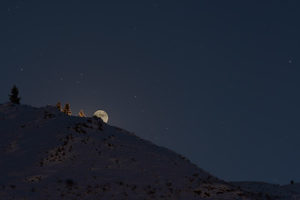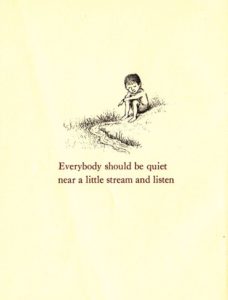Power Path ☆
September 4, 2017[photo: Nils Ribi]
September 6: Full Moon is Wednesday, September 6 at 1:03AM Mountain Daylight Time (MDT). You can also honor this moon the night of the 5th. The full moon marks a time of intensity. They say that you should always face your opponent, your fear, your challenge head on without cowering or showing fear. Not that this full moon is anything to fear, however it does mark a time of big energy that can be quite emotional.
We recommend that you use this moon to acknowledge courage, expansion, showing up and your own power and ability to change, adjust and be more. Use this full moon to energize your physical, emotional and spiritual self. Gather some chi from nature, from the sun, from the earth, the sky realm and all the unseen powers and allies around you. If you feel overwhelmed by the enormity, just acknowledge, accept and be OK with it. You’ll get used to it. It is like being sore after exercising a muscle that has not yet been used. If you continue, the discomfort will pass and you will be stronger for it.
The fallout from the eclipse is being well worked. […] There is no going back to “business as usual” nor would you want to. It is best to be as proactive as possible during this time and really work at adjusting yourself and your universe to a new frequency and higher vibration. Not everyone will be capable of this. Get support if you need it, don’t take things personally and stay out of other people’s drama as much as possible. Watch for accidents, pay attention and be present.
Visceral and immersive.
“The Vietnam War,” a 10-part, 18-hour documentary by Ken Burns and Lynn Novick, premieres on PBS on Sunday, Sept. 17.
There are more Vietnamese voices “The Vietnam War” than Burns at first thought necessary. … It has animated three-dimensional maps and foreign-language interviews. There’s rock music, as well as a score commissioned from Trent Reznor and Atticus Ross; Erik Ewers, a longtime editor at Florentine, who has worked on dozens of hours of film chivvied along by ragtime and bluegrass, told me, with feeling, that the opportunity to use “Dazed and Confused,” by Led Zeppelin, was “a dream come true.”
The film includes striking sequences in which well-known black-and-white photographs, always central to Burns’s work, coëxist with color film and color photography. The subject, being recent and contested—and its traumas sometimes evident in the stiffness around the mouths of witnesses—has its own narrative potency. … Still, when the narration begins, its liturgical phrasing, and its reach for a negotiated settlement among viewers, will seem familiar.
[The New Yorker’s Ian Parker]
In “Ken burns Tackles a Different Civil War,” N.Y. Times ideas reporter Jennifer Schuessler says the film “offers an uncannily well-timed reflection of our current societal fractures — a kind of origin story for the culture wars.”
- “The $30 million film, more than 10 years in the making, offers an intensely immersive, often head-spinning history lesson, combining grand sweep and archival depth with sometimes devastatingly emotional first-person interviews with people from all sides (including more than two dozen Vietnamese, from both the winning and losing sides).”
- “There are scenes covering 25 battles, 10 of which are examined from multiple perspectives.”
- “Every word of the script, written by the historian Geoffrey C. Ward, was carefully weighed. And perhaps none were as carefully debated as that opening narration, which describes the war as ending in ‘failure’ (not ‘defeat,’ Mr. Burns noted, though he used the word himself). ‘I think we probably spent six months on the word ‘failure.'”
- “As for ‘begun in good faith,’ Mr. Burns said he stands by those words, which he said reflect the intentions of those who fought the war, even if they are perhaps ‘too generous’ to our leaders.”
- Worth the click: “Shot by Shot: Building a Scene in Ken Burns and Lynn Novick’s Vietnam Epic.”
Labor’s Day of Repose
‘Leisure lives on affirmation. It is not the same as the absence of activity…or even as an inner quiet. It is rather like the stillness int he conversation of lovers, which is fed by their oneness.’
︶⁀°• •° ⁀︶
Maria Popova:
“We get such a kick out of looking forward to pleasures and rushing ahead to meet them that we can’t slow down enough to enjoy them when they come,” Alan Watts observed in 1970, aptly declaring us “a civilization which suffers from chronic disappointment.” Two millennia earlier, Aristotle asserted “This is the main question, with what activity one’s leisure is filled.”
[…]
So how did we end up so conflicted about cultivating a culture of leisure?
In 1948, only a year after the word “workaholic” was coined in Canada and a year before an American career counselor issued the first concentrated countercultural clarion call for rethinking work, the German philosopher Josef Pieper (May 4, 1904–November 6, 1997) penned Leisure, the Basis of Culture (public library) — a magnificent manifesto for reclaiming human dignity in a culture of compulsive workaholism, triply timely today, in an age when we have commodified our aliveness so much as to mistake making a living for having a life.
In a sentiment Pico Iyer would come to echo more than half a century later in his excellent treatise on the art of stillness, Pieper adds:
Leisure is a form of that stillness that is necessary preparation for accepting reality; only the person who is still can hear, and whoever is not still, cannot hear. Such stillness is not mere soundlessness or a dead muteness; it means, rather, that the soul’s power, as real, of responding to the real — a co-respondence, eternally established in nature — has not yet descended into words. Leisure is the disposition of perceptive understanding, of contemplative beholding, and immersion — in the real.
But there is something else, something larger, in this conception of leisure as “non-activity” — an invitation to commune with the immutable mystery of being. Pieper writes:
In leisure, there is … something of the serenity of “not-being-able-to-grasp,” of the recognition of the mysterious character of the world, and the confidence of blind faith, which can let things go as they will.
[…]
Leisure is not the attitude of the one who intervenes but of the one who opens himself; not of someone who seizes but of one who lets go, who lets himself go, and “go under,” almost as someone who falls asleep must let himself go… The surge of new life that flows out to us when we give ourselves to the contemplation of a blossoming rose, a sleeping child, or of a divine mystery — is this not like the surge of life that comes from deep, dreamless sleep?
[full article at brain pickings.org]


